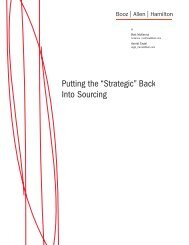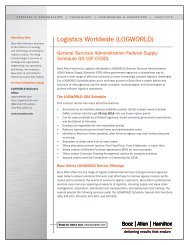Merger Integration: Delivering on the Promise - Booz Allen Hamilton
Merger Integration: Delivering on the Promise - Booz Allen Hamilton
Merger Integration: Delivering on the Promise - Booz Allen Hamilton
You also want an ePaper? Increase the reach of your titles
YUMPU automatically turns print PDFs into web optimized ePapers that Google loves.
<str<strong>on</strong>g>Merger</str<strong>on</strong>g> <str<strong>on</strong>g>Integrati<strong>on</strong></str<strong>on</strong>g>:<br />
<str<strong>on</strong>g>Delivering</str<strong>on</strong>g> <strong>on</strong> <strong>the</strong><br />
<strong>Promise</strong><br />
A Series of Viewpoints <strong>on</strong> <str<strong>on</strong>g>Merger</str<strong>on</strong>g>s, Acquisiti<strong>on</strong>s, and <str<strong>on</strong>g>Integrati<strong>on</strong></str<strong>on</strong>g>
Executive Summary<br />
From airlines to automobiles to advertising, <strong>the</strong> urge to merge has escalated steadily over <strong>the</strong><br />
past decade. In 2000 al<strong>on</strong>e <strong>the</strong>re were 9,472 merger and acquisiti<strong>on</strong> transacti<strong>on</strong>s in <strong>the</strong> United<br />
States — a new record. Although this rush to <strong>the</strong> altar may have been grounded in solid synergistic<br />
potential, all too many of <strong>the</strong>se marriages quickly faltered. <strong>Booz</strong>•<strong>Allen</strong> & Hamilt<strong>on</strong> recently<br />
c<strong>on</strong>ducted a study of deals that closed in 1997 and 1998 and discovered that 53 percent of <strong>the</strong><br />
deals had failed to deliver <strong>the</strong>ir expected results.<br />
Although senior executives devote exhaustive hours to striking <strong>the</strong> right deal, it is merely<br />
<strong>the</strong> beginning of <strong>the</strong> l<strong>on</strong>g and tortuous merger integrati<strong>on</strong> process. In fact, structuring a deal is<br />
relatively easy; implementing <strong>on</strong>e is nothing short of heroic. As an executive presiding over a<br />
newly merged company, you are inundated with competing priorities and demands. But <strong>the</strong> most<br />
important questi<strong>on</strong>s before you are <strong>the</strong>se:<br />
• How do you deliver <strong>on</strong> <strong>the</strong> value you promised shareholders and investors while<br />
simultaneously “keeping <strong>the</strong> wheels <strong>on</strong> <strong>the</strong> business”?<br />
• In <strong>the</strong> wake of a merger, how do you successfully integrate operati<strong>on</strong>s while maintaining<br />
your focus <strong>on</strong> customers?<br />
Although no <strong>on</strong>e-size-fits-all formula can apply to every company’s unique situati<strong>on</strong>, in our<br />
experience four principles are <strong>the</strong> key to success in merger integrati<strong>on</strong>. They all start with <strong>the</strong><br />
CEO — before <strong>the</strong> deal closes.<br />
• Communicate a shared visi<strong>on</strong> for value creati<strong>on</strong>.<br />
• Seize defining moments to make explicit choices and trade-offs.<br />
• Simultaneously execute against competing critical imperatives.<br />
• Employ a rigorous integrati<strong>on</strong> planning process.<br />
These four key principles will dictate a series of transformati<strong>on</strong>al priorities that will, in turn,<br />
shape <strong>the</strong> <strong>on</strong>going game plan and <strong>the</strong> categorizati<strong>on</strong> of day <strong>on</strong>e versus l<strong>on</strong>ger-term tasks. This is an<br />
iterative process. If senior management sticks to it with rigor and clearly communicates evolving<br />
expectati<strong>on</strong>s, <strong>the</strong>re is a str<strong>on</strong>g likelihood that <strong>the</strong>y can realize <strong>the</strong> promise <strong>the</strong>y identified <strong>on</strong> <strong>the</strong><br />
day of <strong>the</strong> merger announcement and keep all <strong>the</strong>ir c<strong>on</strong>stituencies — customers, shareholders,<br />
employees, and o<strong>the</strong>rs — more than satisfied. This Viewpoint outlines <strong>Booz</strong>•<strong>Allen</strong>’s approach to<br />
achieving success in merger integrati<strong>on</strong>.<br />
©2001 <strong>Booz</strong>•<strong>Allen</strong> & Hamilt<strong>on</strong> Inc.
<str<strong>on</strong>g>Merger</str<strong>on</strong>g> <str<strong>on</strong>g>Integrati<strong>on</strong></str<strong>on</strong>g>:<br />
<str<strong>on</strong>g>Delivering</str<strong>on</strong>g> <strong>on</strong> <strong>the</strong> <strong>Promise</strong><br />
A Viewpoint by:<br />
Gerry Adolph<br />
Ian Buchanan<br />
Jennifer Hornery<br />
Bill Jacks<strong>on</strong><br />
John J<strong>on</strong>es<br />
Torbjorn Kihlstedt<br />
Gary Neils<strong>on</strong><br />
Harry Quarls<br />
Most mergers fail. Though this reality is uncomfortable,<br />
it is an indisputable fact. By whatever measure you<br />
choose — stock price, revenues, earnings, return <strong>on</strong><br />
equity — most deals fall short of expectati<strong>on</strong>s. Somewhere between<br />
<strong>the</strong> c<strong>on</strong>cept of <strong>the</strong> merger and its executi<strong>on</strong>, <strong>the</strong> promise fades.<br />
Synergies evaporate. Savings vanish. Cultures clash. And <strong>the</strong> CEO<br />
discovers <strong>the</strong> door.<br />
But why? Surely, no <strong>on</strong>e enters into a merger intending to<br />
lose shareholder value. In a few cases, <strong>the</strong> merger itself was simply<br />
ill c<strong>on</strong>ceived: <strong>the</strong> promise was never really <strong>the</strong>re to realize. In most<br />
deals, however, it is ambiguous leadership and poor executi<strong>on</strong> that<br />
prevent companies from capturing <strong>the</strong> full value of a merger.<br />
Although senior executives devote exhaustive hours to striking <strong>the</strong><br />
right deal, it is merely <strong>the</strong> beginning of <strong>the</strong> l<strong>on</strong>g and tortuous merger<br />
integrati<strong>on</strong> process. In fact, structuring a deal is relatively easy;<br />
implementing <strong>on</strong>e is nothing short of heroic.
Although no <strong>on</strong>e-size-fitsall<br />
formula can apply to every<br />
company’s unique situati<strong>on</strong>, in<br />
our experience four principles are<br />
<strong>the</strong> key to success in merger integrati<strong>on</strong>.<br />
They all start with <strong>the</strong><br />
CEO — before <strong>the</strong> deal closes.<br />
1. Communicate a shared visi<strong>on</strong><br />
for value creati<strong>on</strong>.<br />
2. Seize defining moments<br />
to make explicit choices and<br />
trade-offs.<br />
3. Simultaneously execute<br />
against competing critical<br />
imperatives.<br />
4. Employ a rigorous<br />
integrati<strong>on</strong> planning process.<br />
This Viewpoint outlines<br />
<strong>Booz</strong> •<strong>Allen</strong>’s approach to achieving<br />
success in merger integrati<strong>on</strong>.<br />
A Marriage Made in<br />
Purgatory<br />
From airlines to automobiles<br />
to advertising,<br />
<strong>the</strong> urge to merge has<br />
escalated steadily over <strong>the</strong> past<br />
decade. In 2000 al<strong>on</strong>e <strong>the</strong>re were<br />
9,472 merger and acquisiti<strong>on</strong><br />
(M&A) transacti<strong>on</strong>s in <strong>the</strong><br />
United States — a new record. 1<br />
Worldwide, mergers and<br />
acquisiti<strong>on</strong>s through July 20,<br />
2000 were valued at $1.7 trilli<strong>on</strong>,<br />
an 18 percent year-over-year<br />
increase. 2<br />
Although this rush to <strong>the</strong><br />
altar may have been grounded in<br />
solid synergistic potential, all too<br />
many of <strong>the</strong>se marriages quickly<br />
faltered. <strong>Booz</strong> •<strong>Allen</strong> & Hamilt<strong>on</strong><br />
recently c<strong>on</strong>ducted a study of<br />
deals that closed in 1997 and<br />
1998 and discovered that 53 percent<br />
of <strong>the</strong> deals had failed to<br />
“One of <strong>the</strong> best decisi<strong>on</strong>s<br />
we made in <strong>the</strong> merger integrati<strong>on</strong><br />
process was to maintain our focus<br />
<strong>on</strong> customer service, even when<br />
it meant slowing down <strong>the</strong> rush<br />
to exploit synergies. If we kept our<br />
customers satisfied through <strong>the</strong><br />
integrati<strong>on</strong> process, we reas<strong>on</strong>ed,<br />
it was worth delaying <strong>the</strong> savings<br />
for a couple m<strong>on</strong>ths.”<br />
— CEO, medical products<br />
and services company<br />
deliver <strong>the</strong>ir expected results. (To<br />
assess <strong>the</strong>ir post-merger performance<br />
fairly and accurately, we<br />
intenti<strong>on</strong>ally restricted our sample<br />
to those deals that had closed<br />
two or more years ago.)<br />
Fur<strong>the</strong>r analysis revealed<br />
that <strong>the</strong> more strategic <strong>the</strong> rati<strong>on</strong>ale<br />
for <strong>the</strong> merger, <strong>the</strong> greater<br />
<strong>the</strong> likelihood of failure (see<br />
Exhibit 1). Of those combinati<strong>on</strong>s<br />
that were simply intended<br />
to establish or exploit scale<br />
effects, 55 percent achieved <strong>the</strong>ir<br />
objectives. However, of those<br />
Exhibit 1. Extent to Which Deals Met Expectati<strong>on</strong>s Two Years After <strong>the</strong> <str<strong>on</strong>g>Merger</str<strong>on</strong>g> Close<br />
Combined: 55% Met Expectati<strong>on</strong>s<br />
Combined: 32% Met Expectati<strong>on</strong>s<br />
35<br />
Number<br />
of Deals<br />
30<br />
25<br />
20<br />
15<br />
Strategic mergers<br />
are more likely to fail<br />
10<br />
5<br />
0<br />
Achieve Scale<br />
Grow Existing Business Add Capabilities New Business Model<br />
Total Deals<br />
Met Expectati<strong>on</strong>s<br />
Increasingly Strategic Rati<strong>on</strong>ale<br />
Source: <strong>Booz</strong> • <strong>Allen</strong> & Hamilt<strong>on</strong><br />
1<br />
<str<strong>on</strong>g>Merger</str<strong>on</strong>g>stat.<br />
2<br />
Thoms<strong>on</strong> Financial Securities Data.<br />
2
mergers with more strategic<br />
motivati<strong>on</strong>s (e.g., move<br />
upstream or downstream in <strong>the</strong><br />
value chain, add capabilities,<br />
develop a new business model),<br />
<strong>on</strong>ly 32 percent realized <strong>the</strong>ir<br />
visi<strong>on</strong> and objectives.<br />
The widely prevalent<br />
“merger of equals” was also<br />
shown to be more failure pr<strong>on</strong>e.<br />
According to our analysis, mergers<br />
failed almost twice as often<br />
when <strong>the</strong> participants were of<br />
comparable size. Although most<br />
of <strong>the</strong> less<strong>on</strong>s in this Viewpoint<br />
are applicable to all deals, we<br />
will focus primarily <strong>on</strong> <strong>the</strong> issues<br />
attending large-scale mergers of<br />
comparably sized companies.<br />
Integrating companies is<br />
a mammoth undertaking. The<br />
tactical issues are tremendous.<br />
Indeed, when companies<br />
explained why <strong>the</strong>y had not met<br />
expectati<strong>on</strong>s, more than two<br />
thirds cited executi<strong>on</strong>-related<br />
reas<strong>on</strong>s — such as loss of key<br />
staff, poor due diligence, and<br />
delays in communicati<strong>on</strong>. Only<br />
32 percent attributed <strong>the</strong>ir failure<br />
to meet expectati<strong>on</strong>s to more<br />
strategic c<strong>on</strong>cerns such as poor<br />
fit or an overly ambitious visi<strong>on</strong>.<br />
However, whe<strong>the</strong>r tactical<br />
or strategic, problems in merger<br />
performance land <strong>on</strong> <strong>the</strong> same<br />
doorstep: <strong>the</strong>y are attributed to<br />
poor leadership. That is why so<br />
many CEOs lose <strong>the</strong>ir jobs within<br />
two years of <strong>the</strong> close of an<br />
unsuccessful large-scale merger.<br />
According to our research,<br />
am<strong>on</strong>g companies that did not<br />
achieve <strong>the</strong>ir targets, 42 percent<br />
Exhibit 2. Poor <str<strong>on</strong>g>Merger</str<strong>on</strong>g> Performance Leads to CEO Departures<br />
<str<strong>on</strong>g>Merger</str<strong>on</strong>g>s That Met Expectati<strong>on</strong>s<br />
Source: <strong>Booz</strong> • <strong>Allen</strong> & Hamilt<strong>on</strong><br />
saw <strong>the</strong> CEO depart within two<br />
years. That compares with a 16<br />
percent departure rate am<strong>on</strong>g <strong>the</strong><br />
CEOs of successful mergers (see<br />
Exhibit 2).<br />
As an executive presiding<br />
over a newly merged company,<br />
you are inundated with competing<br />
priorities and demands. But<br />
<strong>the</strong> most important questi<strong>on</strong>s<br />
before you are <strong>the</strong>se:<br />
• How do you deliver <strong>on</strong> <strong>the</strong><br />
value you promised shareholders<br />
and investors while simultaneously<br />
“keeping <strong>the</strong> wheels <strong>on</strong><br />
<strong>the</strong> business”?<br />
• In <strong>the</strong> wake of a merger, how<br />
do you successfully integrate<br />
operati<strong>on</strong>s while maintaining<br />
your focus <strong>on</strong> customers?<br />
84% CEO Remained 58%<br />
After Two Years<br />
It’s important to start <strong>the</strong><br />
merger integrati<strong>on</strong> process as so<strong>on</strong><br />
as possible. To be successful, you<br />
must sow <strong>the</strong> seeds of integrati<strong>on</strong><br />
<str<strong>on</strong>g>Merger</str<strong>on</strong>g>s That Did Not<br />
Meet Expectati<strong>on</strong>s<br />
16% CEO Departed<br />
42%<br />
within Two Years<br />
well before <strong>the</strong> deal closes. That<br />
means making <strong>the</strong> following<br />
decisi<strong>on</strong>s early:<br />
• How will we create value?<br />
• How will we approach and<br />
structure <strong>the</strong> merger?<br />
• How will we lead and manage<br />
<strong>the</strong> integrati<strong>on</strong>?<br />
• What is our people strategy<br />
for <strong>the</strong> transiti<strong>on</strong> to <strong>the</strong> merged<br />
organizati<strong>on</strong>?<br />
The unique characteristics<br />
of <strong>the</strong> deal will dictate <strong>the</strong> particular<br />
choices you make in each<br />
area; <strong>the</strong>re is no <strong>on</strong>e-size-fits-all<br />
recipe for successful merger<br />
integrati<strong>on</strong>. Comprehensive due<br />
diligence will inform <strong>the</strong>se early<br />
decisi<strong>on</strong>s, which will <strong>the</strong>n become<br />
<strong>the</strong> foundati<strong>on</strong> of a rigorous integrati<strong>on</strong><br />
planning process. The<br />
result: both organizati<strong>on</strong>s will be<br />
ready to integrate immediately<br />
after <strong>the</strong> merger’s close.<br />
3
The Four Principles<br />
of Success<br />
Our experience helping<br />
hundreds of companies<br />
throughout <strong>the</strong> world<br />
go through <strong>the</strong> merger integrati<strong>on</strong><br />
process has distilled four<br />
key principles of success, all of<br />
which start with <strong>the</strong> CEO (see<br />
Exhibit 3).<br />
PRINCIPLE 1:<br />
COMMUNICATE A<br />
SHARED VISION FOR<br />
VALUE CREATION<br />
Exhibit 3. The CEO’s Four Principles<br />
Source: <strong>Booz</strong> • <strong>Allen</strong> & Hamilt<strong>on</strong><br />
Communicate a shared visi<strong>on</strong><br />
for value creati<strong>on</strong><br />
Seize defining moments to make<br />
explicit choices and trade-offs<br />
Simultaneously execute against<br />
competing critical imperatives<br />
Employ a rigorous<br />
integrati<strong>on</strong> planning process<br />
<str<strong>on</strong>g>Merger</str<strong>on</strong>g> <str<strong>on</strong>g>Integrati<strong>on</strong></str<strong>on</strong>g> Success<br />
We have no doubt that every<br />
company goes into a merger with<br />
a <strong>on</strong>e- or two-sentence descripti<strong>on</strong><br />
of what <strong>the</strong> deal is all about.<br />
And we have no doubt that a<br />
lot of time and effort goes into<br />
crafting that statement. However,<br />
we suggest that <strong>the</strong> senior leadership<br />
team dig even deeper,<br />
bey<strong>on</strong>d <strong>the</strong> immediate rati<strong>on</strong>ale<br />
to <strong>the</strong> real and sustainable sources<br />
of value <strong>the</strong>y hope to unleash in<br />
<strong>the</strong> merger, and <strong>the</strong>n be aggressive<br />
and open in quantifying and<br />
communicating those sources of<br />
value to vested parties — employees,<br />
customers, and shareholders.<br />
A true shared visi<strong>on</strong> for<br />
value creati<strong>on</strong>:<br />
• Specifically identifies sources<br />
of value<br />
• Sets high aspirati<strong>on</strong>s for financial<br />
growth and synergy<br />
• Is shared by both companies’<br />
senior teams<br />
• Is communicated broadly<br />
and c<strong>on</strong>stantly<br />
This visi<strong>on</strong> is acti<strong>on</strong>able. It<br />
spells out <strong>the</strong> strategic rati<strong>on</strong>ale<br />
for <strong>the</strong> merger and <strong>the</strong> goals for<br />
what <strong>the</strong> merged company can<br />
become. It gives <strong>the</strong> new leadership<br />
team marching orders and<br />
allows <strong>the</strong> organizati<strong>on</strong> as a<br />
whole to understand <strong>the</strong> immediate<br />
priorities in integrating<br />
systems, people, and processes.<br />
It sets stretch targets for financial<br />
growth and synergy capture (see<br />
Exhibit 4) so that <strong>the</strong> promise of<br />
<strong>the</strong> merger can be fully realized.<br />
“A merger is like a marriage —<br />
it’s all about people and <strong>the</strong>ir<br />
ability to work toge<strong>the</strong>r in a way<br />
that benefits <strong>the</strong> uni<strong>on</strong>. The basis<br />
for success includes a comm<strong>on</strong><br />
understanding and assessment<br />
of what both sides bring to <strong>the</strong><br />
party, and what <strong>the</strong> promise of<br />
<strong>the</strong> uni<strong>on</strong> is to be.”<br />
— CEO, global software<br />
developer<br />
Moreover, <strong>the</strong> visi<strong>on</strong> is<br />
truly shared — a noti<strong>on</strong> frequently<br />
embraced in public statements<br />
but all too often disregarded<br />
in practice. Both companies’<br />
senior teams need to understand<br />
and support <strong>the</strong> visi<strong>on</strong> of what<br />
<strong>the</strong> merged company is trying to<br />
accomplish in order to realize<br />
those goals.<br />
It is imperative that <strong>the</strong><br />
companies be forthright and<br />
c<strong>on</strong>sistent in <strong>the</strong>ir communicati<strong>on</strong><br />
of this shared visi<strong>on</strong> for<br />
value creati<strong>on</strong> and <strong>the</strong>n “walk<br />
<strong>the</strong> talk.” The most successful<br />
4
Exhibit 4. The Visi<strong>on</strong> Sets Stretch Financial and Synergy Targets<br />
Minimum Requirements<br />
Stretch Goals for a Successful <str<strong>on</strong>g>Merger</str<strong>on</strong>g><br />
Ensure Survival by<br />
Improving Ec<strong>on</strong>omics<br />
Grow Existing Businesses<br />
Build New Business Model<br />
New Industry Model<br />
• Rati<strong>on</strong>alize costs<br />
• Capture scale ec<strong>on</strong>omics<br />
+<br />
• Build market-leading positi<strong>on</strong>s<br />
in existing business lines<br />
+<br />
• Leverage existing capabilities<br />
to change <strong>the</strong> way you do<br />
business<br />
+<br />
• Use <strong>the</strong> merged company<br />
to redefine <strong>the</strong> industry or<br />
to define new opportunities<br />
Increasing Aspirati<strong>on</strong>s<br />
Source: <strong>Booz</strong> • <strong>Allen</strong> & Hamilt<strong>on</strong><br />
merger integrati<strong>on</strong> efforts leverage<br />
multiple communicati<strong>on</strong><br />
channels and do not underestimate<br />
<strong>the</strong> power of <strong>the</strong> daily<br />
dialogue between supervisor and<br />
employee. C<strong>on</strong>stant and updated<br />
communicati<strong>on</strong>s serve as a<br />
reality check for employees as<br />
<strong>the</strong>y make daily decisi<strong>on</strong>s.<br />
Finally, <strong>the</strong> organizati<strong>on</strong><br />
needs to be equipped with <strong>the</strong><br />
means to translate <strong>the</strong> words of<br />
<strong>the</strong> visi<strong>on</strong> into deeds to effect a<br />
transiti<strong>on</strong> and successfully integrate<br />
people and assets. For<br />
example, we had a client whose<br />
visi<strong>on</strong> was to use mergers and<br />
acquisiti<strong>on</strong>s to become <strong>the</strong> producer<br />
of choice in <strong>the</strong> premium<br />
beverage segment. The company<br />
translated that visi<strong>on</strong> into acti<strong>on</strong><br />
by developing a three-pr<strong>on</strong>ged<br />
plan: 1) build a full product portfolio<br />
for its distributors, reducing<br />
<strong>the</strong> distributors’ dependence <strong>on</strong><br />
o<strong>the</strong>r suppliers; 2) establish <strong>the</strong><br />
scale necessary to capture benefit<br />
al<strong>on</strong>g <strong>the</strong> full value chain; and<br />
3) wield sufficient clout to alter<br />
industry relati<strong>on</strong>ships with<br />
distributors and retailers.<br />
That clearly articulated<br />
rati<strong>on</strong>ale had direct implicati<strong>on</strong>s<br />
for <strong>the</strong> client’s merger planning<br />
and executi<strong>on</strong> processes. It called<br />
for a rati<strong>on</strong>alizati<strong>on</strong> of <strong>the</strong> supplier<br />
base, <strong>the</strong> development of<br />
new relati<strong>on</strong>ship management<br />
capabilities, and <strong>the</strong> formati<strong>on</strong> of<br />
processes to capture <strong>the</strong> “best of<br />
<strong>the</strong> best.” It helped senior management<br />
in designing <strong>the</strong> “new”<br />
organizati<strong>on</strong>, establishing HR<br />
policies, and outlining <strong>the</strong> operati<strong>on</strong>s<br />
footprint. It was a clear,<br />
acti<strong>on</strong>able visi<strong>on</strong>.<br />
PRINCIPLE 2:<br />
SEIZE DEFINING<br />
MOMENTS TO MAKE<br />
EXPLICIT CHOICES<br />
AND TRADE-OFFS<br />
Successful merger integrati<strong>on</strong><br />
hinges <strong>on</strong> <strong>the</strong> senior leadership<br />
team’s recognizing key moments<br />
of truth in <strong>the</strong> merger process<br />
and acting decisively. They must<br />
c<strong>on</strong>sciously identify and evaluate<br />
all opti<strong>on</strong>s and make explicit<br />
choices and trade-offs, recognizing<br />
that some choices will be<br />
very clear (given <strong>the</strong> visi<strong>on</strong> and<br />
<strong>the</strong> characteristics of <strong>the</strong> deal),<br />
while o<strong>the</strong>rs will require great<br />
c<strong>on</strong>victi<strong>on</strong> and fortitude.<br />
As we indicated in <strong>the</strong><br />
introducti<strong>on</strong>, four fundamental<br />
questi<strong>on</strong>s should drive <strong>the</strong> character<br />
and pace of any integrati<strong>on</strong><br />
effort (see Exhibit 5).<br />
First, you need to ask <strong>the</strong><br />
fundamental questi<strong>on</strong> “How will<br />
we create value?” There will<br />
almost certainly be profound<br />
trade-offs when you address this<br />
questi<strong>on</strong>. What will you need to<br />
preserve to realize <strong>the</strong> potential<br />
of <strong>the</strong> deal? And what are you<br />
prepared to relinquish in return?<br />
Where should you redesign,<br />
create, adopt, or eliminate — and<br />
should you make <strong>the</strong>se decisi<strong>on</strong>s<br />
by segment, organizati<strong>on</strong>,<br />
process, or geography? What are<br />
<strong>the</strong> immediate priorities and<br />
what can wait?<br />
The sec<strong>on</strong>d fundamental<br />
questi<strong>on</strong> c<strong>on</strong>cerns how you<br />
approach and structure <strong>the</strong><br />
merger. Will you absorb, integrate,<br />
create, or attach? Will you<br />
take a “best of both” approach<br />
5
Exhibit 5. Fundamental Questi<strong>on</strong>s Drive <str<strong>on</strong>g>Integrati<strong>on</strong></str<strong>on</strong>g><br />
How will we<br />
create value?<br />
• What must we preserve to realize <strong>the</strong> potential of this deal? What are we<br />
prepared to give up?<br />
• Where do we redesign, create, adopt, or eliminate? (By segment, organizati<strong>on</strong>,<br />
process, or geography?)<br />
• Where do we need to compete as an instituti<strong>on</strong>?<br />
• What must be integrated immediately? What can wait?<br />
Visi<strong>on</strong><br />
How will we<br />
approach this<br />
merger?<br />
• Do we absorb, integrate, create, or attach?<br />
• Will we apply a “best of both” philosophy, or is <strong>the</strong>re a preference for ei<strong>the</strong>r<br />
company’s model?<br />
• Will this philosophy apply to <strong>the</strong> senior team selecti<strong>on</strong>?<br />
How will<br />
this merger<br />
be led?<br />
• What role should <strong>the</strong> CEO play?<br />
• How will we run <strong>the</strong> business while simultaneously maintaining focus <strong>on</strong> <strong>the</strong><br />
integrati<strong>on</strong> and its synergies?<br />
• How aggressive do we want to be?<br />
• How should teams be formed? How much line involvement?<br />
What people<br />
strategy is<br />
required?<br />
• What is <strong>the</strong> decisi<strong>on</strong>-making model? (Top-down, bottom-up?)<br />
• What degree of cultural change is required to make this work?<br />
• How do we identify, select, and retain a superior team?<br />
• How can we ensure that we treat people fairly?<br />
Source: <strong>Booz</strong> • <strong>Allen</strong> & Hamilt<strong>on</strong><br />
when it comes to adopting <strong>the</strong><br />
companies’ practices, or will <strong>on</strong>e<br />
company clearly dominate <strong>the</strong><br />
o<strong>the</strong>r? Finally, will this philosophy<br />
apply to your selecti<strong>on</strong> of<br />
<strong>the</strong> senior team? The nature and<br />
strategic intent of <strong>the</strong> deal will<br />
lead to some specific choices.<br />
For example, if <strong>the</strong> deal is a<br />
“bolt-<strong>on</strong>,” in which <strong>on</strong>e company<br />
is simply acquiring ano<strong>the</strong>r’s<br />
revenues at a marginal fixed cost,<br />
<strong>the</strong>n <strong>the</strong> integrati<strong>on</strong> approach is<br />
largely decided: absorb. But most<br />
deals of any size — our focus in<br />
this Viewpoint — involve a more<br />
complex set of competing issues.<br />
Third, you need to ask<br />
yourself how <strong>the</strong> integrati<strong>on</strong><br />
should be led. Should <strong>the</strong> CEO<br />
play a prominent role? How<br />
will you keep current businesses<br />
running smoothly while integrating<br />
new assets and realizing<br />
synergies? How aggressive do<br />
you want to be in exploiting new<br />
value? Once again, <strong>the</strong> nature<br />
of <strong>the</strong> deal and its impact <strong>on</strong><br />
industry structure will lead to<br />
certain choices. As <strong>on</strong>e CEO<br />
overseeing a mega-merger in his<br />
industry observed, “You have to<br />
be willing to bet <strong>the</strong> firm, and<br />
drive every aspect of <strong>the</strong> integrati<strong>on</strong><br />
pers<strong>on</strong>ally.”<br />
Finally, what people strategy<br />
will be required? Will you use a<br />
top-down or bottom-up decisi<strong>on</strong>making<br />
model? How will you<br />
integrate different cultures? How<br />
will you retain top performers<br />
while treating every<strong>on</strong>e with fairness<br />
and respect?<br />
Some of <strong>the</strong>se choices will<br />
be obvious given <strong>the</strong> nature of<br />
<strong>the</strong> deal. For example, in our<br />
experience clients who paid large<br />
premiums approach merger integrati<strong>on</strong><br />
very aggressively. To<br />
recover <strong>the</strong>ir investment, <strong>the</strong>y<br />
target early wins and exploit<br />
synergies immediately. A hostile<br />
6
takeover situati<strong>on</strong> requires an<br />
early emphasis <strong>on</strong> people strategy.<br />
Such companies need to retain<br />
key talent and ensure knowledge<br />
capture. A high-profile deal with<br />
some market skepticism will<br />
require <strong>the</strong> CEO to play a visible<br />
role in <strong>the</strong> integrati<strong>on</strong> effort. And,<br />
depending <strong>on</strong> <strong>the</strong> sources of value<br />
you have identified, <strong>the</strong>se will<br />
necessarily be given <strong>the</strong> highest<br />
priority as you focus resources<br />
<strong>on</strong> creating value post-merger.<br />
As Exhibit 6 highlights,<br />
each choice involves a trade-off.<br />
Whe<strong>the</strong>r it c<strong>on</strong>cerns <strong>the</strong> integrati<strong>on</strong><br />
approach, <strong>the</strong> desired<br />
culture, or <strong>the</strong> role of <strong>the</strong> CEO,<br />
each choice is made from a<br />
range of opti<strong>on</strong>s. In exploiting<br />
synergies, you can focus simply<br />
<strong>on</strong> reducing existing costs or you<br />
can strive to create new primary<br />
demand. In developing <strong>the</strong> new<br />
organizati<strong>on</strong>, you can choose <strong>on</strong>e<br />
model and jettis<strong>on</strong> <strong>the</strong> o<strong>the</strong>r —<br />
or clean <strong>the</strong> slate entirely. In<br />
retaining people you can adopt<br />
a passive approach or take a<br />
more active stand with targeted<br />
individuals. It’s a whole new ball<br />
game, and you get to establish<br />
<strong>the</strong> rules… all at <strong>on</strong>ce… in<br />
real time.<br />
It’s in <strong>the</strong>se CEO-level<br />
decisi<strong>on</strong>s that <strong>the</strong> future success<br />
of <strong>the</strong> merger lies. If you can<br />
pick your spot in each of <strong>the</strong>se<br />
areas and establish a stake before<br />
<strong>the</strong> merger even closes, you’ve<br />
g<strong>on</strong>e a l<strong>on</strong>g way toward ensuring<br />
<strong>the</strong> effectiveness of your postmerger<br />
integrati<strong>on</strong> efforts.<br />
Exhibit 6. Each Choice Entails a Trade-Off<br />
Specific Choices and Trade-Offs<br />
How will we<br />
create value?<br />
Source of Synergies<br />
Cost Reducti<strong>on</strong><br />
Selected Redesign<br />
True Synergy Potential<br />
Stakeholder C<strong>on</strong>cessi<strong>on</strong>s<br />
Targeted, Measured<br />
Generous<br />
How will we<br />
approach this<br />
merger?<br />
<str<strong>on</strong>g>Integrati<strong>on</strong></str<strong>on</strong>g> Approach<br />
New Organizati<strong>on</strong><br />
Absorpti<strong>on</strong><br />
Choose One of Two<br />
Best of Both<br />
Harm<strong>on</strong>ize<br />
Transform<br />
Clean Slate<br />
How will<br />
this merger<br />
be led?<br />
Synergy Prosecuti<strong>on</strong><br />
Preclose Planning<br />
C<strong>on</strong>servative<br />
C<strong>on</strong>servative, Limited<br />
Stretch, Fast-Paced<br />
Aggressive, Maximize Planning<br />
Decisi<strong>on</strong>-Making Involvement<br />
Broad Involvement, Decentralized<br />
Programmatic, Centralized<br />
CEO Role<br />
Selected Delegati<strong>on</strong><br />
<str<strong>on</strong>g>Integrati<strong>on</strong></str<strong>on</strong>g> Champi<strong>on</strong><br />
What people<br />
strategy is<br />
required?<br />
Leadership and Employee Selecti<strong>on</strong><br />
Desired Culture<br />
Acquiring Team Dominates<br />
Emergent<br />
Allow One to Dominate<br />
Best Team<br />
Craft New Culture<br />
Retenti<strong>on</strong><br />
Passive, Selective<br />
Active, Targeted<br />
Source: <strong>Booz</strong> • <strong>Allen</strong> & Hamilt<strong>on</strong><br />
7
PRINCIPLE 3:<br />
SIMULTANEOUSLY<br />
EXECUTE AGAINST<br />
COMPETING CRITICAL<br />
IMPERATIVES<br />
Companies need to balance<br />
several critical imperatives<br />
simultaneously as <strong>the</strong>y map out<br />
and engage in <strong>the</strong> merger integrati<strong>on</strong><br />
process (see Exhibit 7).<br />
Translate <strong>the</strong> Shared Visi<strong>on</strong><br />
As we menti<strong>on</strong>ed before,<br />
<strong>the</strong> CEO’s visi<strong>on</strong> must be acti<strong>on</strong>able.<br />
The organizati<strong>on</strong> must be<br />
equipped with <strong>the</strong> means to<br />
translate mere words into deeds<br />
to effect a transiti<strong>on</strong> and successfully<br />
integrate people and assets.<br />
The balancing act here is to<br />
provide a road map clear enough<br />
to allow those implementing <strong>the</strong><br />
visi<strong>on</strong> to know specifically what<br />
<strong>the</strong>y need to do — while not<br />
smo<strong>the</strong>ring <strong>the</strong> energy and<br />
creativity that it takes to realize<br />
<strong>the</strong> prize (that is, deliver <strong>on</strong><br />
<strong>the</strong> commitments made at <strong>the</strong><br />
time of <strong>the</strong> announcement).<br />
Create One Company<br />
The challenge of creating <strong>on</strong>e<br />
company from two formerly<br />
independent — and quite often<br />
competitive — organizati<strong>on</strong>s<br />
looms large. Those leading <strong>the</strong><br />
new organizati<strong>on</strong> must quickly<br />
move bey<strong>on</strong>d rhetoric to truly<br />
combine <strong>the</strong> two companies and<br />
create a single, bigger, and better<br />
competitor. The pitfalls are<br />
numerous (see Exhibit 8), but<br />
<strong>the</strong> opportunities to create new<br />
value are even more prolific.<br />
Exhibit 7. Imperatives for Successful <str<strong>on</strong>g>Integrati<strong>on</strong></str<strong>on</strong>g><br />
Stable<br />
Operati<strong>on</strong>s<br />
Source: <strong>Booz</strong> • <strong>Allen</strong> & Hamilt<strong>on</strong><br />
Close<br />
Value<br />
Capture<br />
Build Stakeholder Enthusiasm<br />
In <strong>the</strong> wake of a merger<br />
announcement, CEOs and <strong>the</strong>ir<br />
senior managers must direct <strong>the</strong>ir<br />
focus not <strong>on</strong>ly within but also<br />
outside <strong>the</strong> organizati<strong>on</strong> and rally<br />
<strong>the</strong> enthusiasm of <strong>the</strong> various<br />
stakeholders that <strong>the</strong> new company<br />
will need to succeed. Good<br />
intenti<strong>on</strong>s do not always translate<br />
into good communicati<strong>on</strong>, which<br />
is unfortunate, since it is critical<br />
that key stakeholders — be <strong>the</strong>y<br />
shareholders, customers, employees,<br />
suppliers, or regulators —<br />
fully buy in to <strong>the</strong> potential of<br />
a merger.<br />
Everything communicates,<br />
not just press releases and official<br />
bulletins. You send a clear<br />
message to customers, for example,<br />
when you increase prices in<br />
<strong>the</strong> wake of a merger or cause<br />
customers to suffer service<br />
Translate<br />
Visi<strong>on</strong><br />
Successful<br />
<str<strong>on</strong>g>Integrati<strong>on</strong></str<strong>on</strong>g><br />
Energized<br />
Team<br />
One<br />
Company<br />
Stakeholder<br />
Enthusiasm<br />
disrupti<strong>on</strong>s. What to say, to<br />
whom, when, and by whom are<br />
all critical <strong>on</strong>going decisi<strong>on</strong>s<br />
that need to be made quickly<br />
and clearly as part of an overall<br />
communicati<strong>on</strong>s strategy that<br />
balances c<strong>on</strong>flicting interests<br />
and messages.<br />
It is tempting to tell every<strong>on</strong>e<br />
what <strong>the</strong>y want to hear, but<br />
rarely, if ever, is that a feasible<br />
or realistic goal. The merger will,<br />
necessarily, create winners and<br />
losers am<strong>on</strong>g your various c<strong>on</strong>stituencies.<br />
In communicating<br />
with each of <strong>the</strong>m, you should<br />
emphasize as h<strong>on</strong>estly as possible<br />
what’s in it for <strong>the</strong>m — al<strong>on</strong>g<br />
with <strong>the</strong> value propositi<strong>on</strong> <strong>the</strong><br />
newly combined company offers.<br />
For those who stand to benefit,<br />
regularly dem<strong>on</strong>strate progress;<br />
for those who will be negatively<br />
affected by <strong>the</strong> merger, mitigate<br />
8
Exhibit 8. Merging Two Companies: The Pitfalls and Opportunities<br />
C<strong>on</strong>tent<br />
Culture<br />
Pitfall<br />
• Focusing <strong>on</strong> combining operati<strong>on</strong>s instead of<br />
capturing synergies or best practices<br />
• Relying too heavily <strong>on</strong> naturally occurring synergies<br />
• Thinking of “organizati<strong>on</strong>” as purely “structure”<br />
• Worrying about culture comparis<strong>on</strong>s between<br />
<strong>the</strong> two organizati<strong>on</strong>s<br />
• Assuming a single prevailing culture in each organizati<strong>on</strong><br />
Opportunity<br />
• Taking advantage of <strong>the</strong> merger to implement new strategies,<br />
processes, roles, and resp<strong>on</strong>sibilities<br />
• Taking advantage of external windows of opportunity<br />
(e.g., customers, partners, financial)<br />
• Building a culture that is appropriately different from that of<br />
ei<strong>the</strong>r predecessor<br />
Change<br />
• Failing to engage <strong>the</strong> whole organizati<strong>on</strong><br />
• Stopping short of significant change<br />
• Leveraging people’s expectati<strong>on</strong> of significant change to<br />
drive major improvements<br />
Leadership<br />
• Reinforcing <strong>the</strong> status quo<br />
• Letting intercompany equity overshadow finding<br />
<strong>the</strong> best people<br />
• Setting a new directi<strong>on</strong><br />
Executi<strong>on</strong><br />
• Failing to achieve targeted savings and timing<br />
• Disrupting <strong>the</strong> business because of poor integrati<strong>on</strong><br />
• Using due diligence and <strong>the</strong> preclose period to plan <strong>the</strong><br />
integrati<strong>on</strong> in detail<br />
• Deploying sufficient high-quality resources<br />
• Establishing an organizati<strong>on</strong>al structure to m<strong>on</strong>itor and<br />
drive progress<br />
Source: <strong>Booz</strong> • <strong>Allen</strong> & Hamilt<strong>on</strong><br />
fears. Focus first <strong>on</strong> those stakeholders,<br />
particularly customers,<br />
who are most at risk.<br />
One Australia-based building<br />
products company we spoke<br />
with started managing its stakeholders<br />
even before it identified<br />
a merger partner. The CEO<br />
pursued discussi<strong>on</strong>s with industry<br />
peers while simultaneously<br />
preparing <strong>the</strong> ground with<br />
his board and shareholders by<br />
educating <strong>the</strong>m <strong>on</strong> <strong>the</strong> underlying<br />
forces affecting <strong>the</strong> company<br />
and its growth opti<strong>on</strong>s. This CEO<br />
saw this exercise as “earning <strong>the</strong><br />
right to do a deal.”<br />
<strong>Booz</strong> •<strong>Allen</strong> Client Case Study: Building Stakeholder Enthusiasm<br />
Client Situati<strong>on</strong><br />
On <strong>the</strong> heels of a competitor’s failed acquisiti<strong>on</strong> attempt, our client entered<br />
tense negotiati<strong>on</strong>s with <strong>the</strong> target, a c<strong>on</strong>sumer and health products company.<br />
Acti<strong>on</strong>s Taken<br />
A forceful and comprehensive public relati<strong>on</strong>s campaign was waged to<br />
c<strong>on</strong>vince stakeholders of <strong>the</strong> merits of <strong>the</strong> deal:<br />
• An aggressive communicati<strong>on</strong>s program was aimed at instituti<strong>on</strong>al<br />
investors and <strong>the</strong> board of <strong>the</strong> target company, stressing <strong>the</strong> merits<br />
of <strong>the</strong> deal compared with those offered by <strong>the</strong> alternative suitor.<br />
• A clear, simple message surrounded all merger communicati<strong>on</strong>s.<br />
• The company put an emphasis <strong>on</strong> <strong>the</strong> speed of closing.<br />
Results<br />
The company received positive press coverage of <strong>the</strong> deal merits and closed<br />
<strong>the</strong> acquisiti<strong>on</strong> expeditiously.<br />
9
Unleash an Energized Team<br />
Possibly <strong>the</strong> greatest challenge in<br />
merger integrati<strong>on</strong> is building an<br />
energized and enthusiastic team<br />
comprising <strong>the</strong> best of both<br />
organizati<strong>on</strong>s. It is <strong>the</strong> nature of<br />
any acquired company to resist<br />
directives, and employees at both<br />
companies will be c<strong>on</strong>sumed<br />
with questi<strong>on</strong>s about <strong>the</strong>ir individual<br />
futures in <strong>the</strong> wake of a<br />
merger announcement. Asking<br />
<strong>the</strong>m to enlist in your shared<br />
visi<strong>on</strong> without first allaying <strong>the</strong>ir<br />
c<strong>on</strong>cerns about where <strong>the</strong>y fit<br />
into <strong>the</strong> new organizati<strong>on</strong> is<br />
an exercise in futility.<br />
Buy-in is a cascading<br />
process, so <strong>the</strong> obvious starting<br />
point is <strong>the</strong> leadership team. The<br />
CEO’s selecti<strong>on</strong> of his or her<br />
senior officers will set <strong>the</strong> t<strong>on</strong>e<br />
for <strong>the</strong> new organizati<strong>on</strong>’s people<br />
strategy. Of course, whe<strong>the</strong>r people<br />
stay is <strong>the</strong> result of countless<br />
decisi<strong>on</strong>s made at every level.<br />
How positi<strong>on</strong>s are filled is as<br />
important as who fills <strong>the</strong>m. How<br />
positi<strong>on</strong>s are “unfilled” is<br />
arguably even more important.<br />
We’ve seen client situati<strong>on</strong>s in<br />
which <strong>the</strong> casual assigning of<br />
office space brings entire departments<br />
to a halt.<br />
True buy-in comes when<br />
employees understand clearly<br />
what is being asked of <strong>the</strong>m and<br />
what opportunities for pers<strong>on</strong>al<br />
growth await <strong>the</strong>m if <strong>the</strong>y say yes.<br />
What are <strong>the</strong> career prospects?<br />
What are <strong>the</strong> financial upsides?<br />
In short, “What’s in it for me?”<br />
Capture <strong>the</strong> Value<br />
Through Synergies<br />
There will be significant pressure<br />
<strong>on</strong> <strong>the</strong> CEO and senior management<br />
to “realize <strong>the</strong> prize” in <strong>the</strong><br />
first year or two. After <strong>the</strong> deal is<br />
paid for, <strong>the</strong>se executives <strong>the</strong>n<br />
need to justify it by delivering<br />
c<strong>on</strong>tinuing upside. This is particularly<br />
difficult to do while you<br />
are trying to avoid a tide of<br />
employee departures and make<br />
sure your customer orders are<br />
filled. The trick is to identify <strong>the</strong><br />
appropriate combinati<strong>on</strong> of<br />
short- and l<strong>on</strong>g-term synergies<br />
that will give external stakeholders<br />
faith in your promise of <strong>the</strong><br />
prize, but that will not sap <strong>the</strong><br />
organizati<strong>on</strong> of energy, <strong>the</strong>reby<br />
sabotaging <strong>the</strong> promise.<br />
From our research and<br />
experience, most stakeholders<br />
grant you about six to 12 m<strong>on</strong>ths<br />
to deliver short-term synergies.<br />
Bey<strong>on</strong>d that time, <strong>the</strong>y expect<br />
you to start delivering <strong>the</strong><br />
upsides.<br />
So where do you start looking<br />
for this balance of synergies?<br />
First, it is critical to develop a<br />
solid fact base from which to<br />
build. This baseline provides a<br />
starting point and will allow<br />
teams to map <strong>the</strong> organizati<strong>on</strong>s<br />
against <strong>on</strong>e ano<strong>the</strong>r. Teams<br />
should <strong>the</strong>n be given <strong>the</strong> task<br />
of looking for creative ways to<br />
improve <strong>the</strong> way business is<br />
d<strong>on</strong>e, getting bey<strong>on</strong>d redundancybased<br />
synergies.<br />
Maintain Stable Operati<strong>on</strong>s<br />
In <strong>the</strong> midst of mounting external<br />
pressures and multiple distracti<strong>on</strong>s<br />
and c<strong>on</strong>flicts, it is easy for<br />
senior executives to lose sight of<br />
<strong>the</strong>ir primary resp<strong>on</strong>sibility: to<br />
keep <strong>the</strong> wheels <strong>on</strong> <strong>the</strong> bus. That<br />
goal is achieved by focusing <strong>on</strong><br />
<strong>Booz</strong> •<strong>Allen</strong> Client Case Study: Maintaining Stable Operati<strong>on</strong>s<br />
Client Situati<strong>on</strong><br />
Our client in <strong>the</strong> aerospace and defense industry acquired a company in<br />
a similar line of business for a low premium. It was important to ensure<br />
minimal disrupti<strong>on</strong> to business operati<strong>on</strong>s given strict quality and timing<br />
requirements <strong>on</strong> existing key customer c<strong>on</strong>tracts.<br />
Acti<strong>on</strong>s Taken<br />
It was determined that many sites would ultimately be closed, but <strong>the</strong><br />
low acquisiti<strong>on</strong> premium meant that <strong>the</strong> client had time to pursue this<br />
c<strong>on</strong>solidati<strong>on</strong> strategy more gradually. The client decided to implement<br />
c<strong>on</strong>solidati<strong>on</strong> moves over a period of several years after <strong>the</strong> deal closed.<br />
The CEO also chose to keep <strong>the</strong> name of <strong>the</strong> acquired company, and he<br />
pers<strong>on</strong>ally visited manufacturing sites to address management in an effort<br />
to ease <strong>the</strong> turmoil of <strong>the</strong> acquisiti<strong>on</strong> and ensure that people felt included<br />
and c<strong>on</strong>sulted.<br />
Results<br />
These decisi<strong>on</strong>s made for a smooth and successful integrati<strong>on</strong>.<br />
10
three primary areas: stability,<br />
organizati<strong>on</strong>al c<strong>on</strong>trol, and problem<br />
resoluti<strong>on</strong> (see Exhibit 9).<br />
Both in mergers of equals<br />
and in more straightforward<br />
acquisiti<strong>on</strong>s, a host of issues<br />
threaten to bring <strong>on</strong>going operati<strong>on</strong>s<br />
to a standstill. The key is to<br />
establish stable interim processes<br />
and c<strong>on</strong>trols as well as problem<br />
resoluti<strong>on</strong> mechanisms, so that<br />
<strong>the</strong>re are no debilitating interrupti<strong>on</strong>s<br />
in service or defecti<strong>on</strong>s in<br />
staff. Where are <strong>the</strong> risks to<br />
c<strong>on</strong>tinued business stability?<br />
What can you do <strong>on</strong> a c<strong>on</strong>tingency<br />
basis to address <strong>the</strong>se<br />
risks and prevent fur<strong>the</strong>r escalati<strong>on</strong>?<br />
Although integrati<strong>on</strong><br />
decisi<strong>on</strong>s about <strong>the</strong> future-state<br />
organizati<strong>on</strong> and processes may<br />
take some time, it is imperative<br />
that you immediately resolve outstanding<br />
issues such as delegati<strong>on</strong>s<br />
of authority, payroll, workload<br />
c<strong>on</strong>flicts, and pricing — even if<br />
that involves a temporary soluti<strong>on</strong>.<br />
One individual we interviewed,<br />
<strong>the</strong> CEO of an Australian<br />
c<strong>on</strong>glomerate with extensive<br />
merger and acquisiti<strong>on</strong> experience,<br />
recommends appointing risk<br />
management czars to identify<br />
and address threats to c<strong>on</strong>tinued<br />
business stability. These individuals<br />
should be independent of <strong>the</strong><br />
business units and should report<br />
directly to <strong>the</strong> CEO.<br />
Exhibit 9. Keeping <strong>the</strong> Wheels <strong>on</strong> <strong>the</strong> Bus<br />
Stability<br />
• Defined, stable interim<br />
processes:<br />
– Financial<br />
– Make/deliver<br />
– Selling/pricing/<br />
commitments<br />
– C<strong>on</strong>tracting<br />
– People management<br />
Source: <strong>Booz</strong> • <strong>Allen</strong> & Hamilt<strong>on</strong><br />
Close <strong>the</strong> Deal<br />
It’s telling that <strong>the</strong> final imperative<br />
is to close <strong>the</strong> deal; it <strong>on</strong>ly<br />
serves to emphasize <strong>the</strong> importance<br />
of beginning <strong>the</strong> post-merger<br />
integrati<strong>on</strong> process well before<br />
<strong>the</strong> deal is d<strong>on</strong>e. As <strong>the</strong> CEO of<br />
<strong>the</strong> newly combined entity, you<br />
will need to make key decisi<strong>on</strong>s<br />
and address critical imperatives<br />
in <strong>the</strong> period between signing<br />
<strong>the</strong> agreement and c<strong>on</strong>summating<br />
<strong>the</strong> deal (see Exhibit 10). And,<br />
in doing so, you will need to<br />
balance <strong>the</strong> interests of all key<br />
c<strong>on</strong>stituents: shareholders, customers,<br />
employees, and regulators,<br />
am<strong>on</strong>g o<strong>the</strong>rs.<br />
Although <strong>the</strong> initial memorandum<br />
of understanding will<br />
set <strong>the</strong> broad parameters of <strong>the</strong><br />
merger, <strong>the</strong>re is often much room<br />
for last-minute maneuvering.<br />
Organizati<strong>on</strong>al<br />
C<strong>on</strong>trol<br />
• Who’s my boss?<br />
• Chain of command<br />
• No lost functi<strong>on</strong>s,<br />
activities, groups, people,<br />
customers, etc.<br />
• Ability to exercise c<strong>on</strong>trol<br />
• Not necessarily full<br />
integrati<strong>on</strong><br />
Problem<br />
Resoluti<strong>on</strong><br />
• Identify business<br />
stability risks:<br />
– Customer<br />
– External affairs<br />
– Employee<br />
– Workload c<strong>on</strong>flict<br />
• Resolve or prevent<br />
• Capture and m<strong>on</strong>itor<br />
Different companies approach<br />
<strong>the</strong>se negotiati<strong>on</strong>s in various<br />
ways, depending <strong>on</strong> <strong>the</strong> unique<br />
set of regulatory, competitive,<br />
and merger-specific issues that<br />
pertain to <strong>the</strong>ir particular situati<strong>on</strong>.<br />
The key levers at your<br />
disposal in negotiating final deal<br />
terms will include <strong>the</strong> deal structure,<br />
regulatory commitments<br />
(e.g., pricing, employment, locati<strong>on</strong><br />
of operati<strong>on</strong>s), savings<br />
targets, timing, and <strong>the</strong> distributi<strong>on</strong><br />
of risk.<br />
The trick to closing <strong>the</strong><br />
deal is to achieve a delicate<br />
balance between aggressively<br />
pursuing <strong>the</strong> deal c<strong>on</strong>summati<strong>on</strong><br />
and crossing <strong>the</strong> line <strong>on</strong> legalities<br />
(or rupturing <strong>the</strong> deal altoge<strong>the</strong>r).<br />
11
Exhibit 10. Overall <str<strong>on</strong>g>Integrati<strong>on</strong></str<strong>on</strong>g> Approach<br />
Sale Agreement<br />
Preclose Planning and Design<br />
(Define, Organize, and Launch)<br />
• Agree <strong>on</strong> integrati<strong>on</strong> principles and approach<br />
• Set synergy targets<br />
• Establish preclose integrati<strong>on</strong> infrastructure<br />
and select participants<br />
• Define integrati<strong>on</strong> process and deliverables<br />
• Develop high-level organizati<strong>on</strong>al design<br />
• Teams develop first-pass synergy estimates<br />
• Develop detailed organizati<strong>on</strong>al design<br />
• C<strong>on</strong>firm synergy targets through validati<strong>on</strong><br />
by value creati<strong>on</strong> teams<br />
• Identify low-hanging synergies<br />
• Develop employee transiti<strong>on</strong> plan<br />
• Detail people selecti<strong>on</strong> process and<br />
severance packages<br />
• Develop implementati<strong>on</strong> plan<br />
• Design endgame and transiti<strong>on</strong> organizati<strong>on</strong>s<br />
• Develop customer transiti<strong>on</strong> plan<br />
Close<br />
<str<strong>on</strong>g>Integrati<strong>on</strong></str<strong>on</strong>g> Implementati<strong>on</strong><br />
(Guide, C<strong>on</strong>trol, and Execute)<br />
• Transfer implementati<strong>on</strong> to line<br />
• Track implementati<strong>on</strong><br />
• Identify and resolve key issues<br />
• Integrate synergy targets and plans into<br />
normal budget and planning<br />
• Define integrati<strong>on</strong> management governance<br />
Leadership Selecti<strong>on</strong> (Cascading)<br />
Communicati<strong>on</strong> Strategy<br />
Communicati<strong>on</strong>s Implemented<br />
Due Diligence, Closing <strong>the</strong> Deal<br />
Manage Acquired Company<br />
Source: <strong>Booz</strong> • <strong>Allen</strong> & Hamilt<strong>on</strong><br />
PRINCIPLE 4:<br />
EMPLOY A RIGOROUS<br />
INTEGRATION<br />
PLANNING PROCESS<br />
By <strong>the</strong> time it reaches full swing,<br />
<strong>the</strong> work of post-merger integrati<strong>on</strong><br />
is a massive, multifaceted<br />
campaign involving every functi<strong>on</strong><br />
and business unit al<strong>on</strong>g with<br />
pers<strong>on</strong>nel at multiple levels. But<br />
<strong>the</strong> planning process for this<br />
assault starts small and early<br />
with a design team staffed by a<br />
few select participants. As <strong>the</strong><br />
merger passes through successive<br />
milest<strong>on</strong>es — legal, regulatory,<br />
financial — <strong>the</strong> planning effort<br />
gains specificity as more informati<strong>on</strong><br />
is shared. What started<br />
with <strong>on</strong>e design team proceeds<br />
with multiple teams working in<br />
parallel. These teams spawn<br />
subteams that work <strong>on</strong> specific<br />
initiatives until hundreds of<br />
people are involved in <strong>the</strong><br />
merger integrati<strong>on</strong> process. As<br />
teams evolve over time, <strong>the</strong>y<br />
tackle <strong>the</strong> work implied by <strong>the</strong><br />
key principles in greater and<br />
greater detail.<br />
The first challenges in <strong>the</strong><br />
planning process are to determine<br />
<strong>the</strong> right team structure and<br />
roles, select <strong>the</strong> right people for<br />
<strong>the</strong>se roles, and decide to what<br />
degree you will involve line<br />
management. Most integrati<strong>on</strong><br />
efforts require some combinati<strong>on</strong><br />
of design or value creati<strong>on</strong> teams,<br />
task teams, transacti<strong>on</strong> teams —<br />
and a dedicated team to ensure<br />
that <strong>the</strong> businesses keep running.<br />
Value creati<strong>on</strong> teams are focused<br />
<strong>on</strong> <strong>the</strong> future organizati<strong>on</strong> and<br />
<strong>the</strong> way business will be carried<br />
out as well as how to transiti<strong>on</strong><br />
from <strong>the</strong> current state. Task<br />
teams, in c<strong>on</strong>trast, are almost<br />
solely focused <strong>on</strong> day <strong>on</strong>e critical<br />
activities to support bringing<br />
<strong>the</strong> two organizati<strong>on</strong>s toge<strong>the</strong>r as<br />
<strong>on</strong>e. The transacti<strong>on</strong> team understandably<br />
focuses <strong>on</strong> closing<br />
<strong>the</strong> deal and is generally staffed<br />
with a cross-secti<strong>on</strong> of functi<strong>on</strong>al<br />
experts from legal, finance, and<br />
<strong>the</strong> different businesses.<br />
12
In selecting <strong>the</strong> right<br />
people for <strong>the</strong> roles <strong>on</strong> <strong>the</strong>se<br />
teams, it pays to think about <strong>the</strong><br />
different skills required for<br />
each team. A c<strong>on</strong>scious decisi<strong>on</strong><br />
should be made about <strong>the</strong> ability<br />
of <strong>on</strong>e pers<strong>on</strong> to fulfill both a<br />
value creati<strong>on</strong> team and task team<br />
role. This is particularly important<br />
for <strong>the</strong> support functi<strong>on</strong>s of<br />
human resources, finance, and<br />
informati<strong>on</strong> technology. The integrati<strong>on</strong><br />
support demand <strong>on</strong> <strong>the</strong>se<br />
functi<strong>on</strong>s is enormous, yet <strong>the</strong>y<br />
also need to be thinking about<br />
building an integrated functi<strong>on</strong> to<br />
support <strong>the</strong> future organizati<strong>on</strong>.<br />
The work of <strong>the</strong>se transacti<strong>on</strong>,<br />
task, and value creati<strong>on</strong><br />
teams is <strong>the</strong>n fed into a central<br />
program or integrati<strong>on</strong> coordinati<strong>on</strong><br />
office overseen by a<br />
steering committee of high-level<br />
executives charged with charting<br />
<strong>the</strong> strategic course of <strong>the</strong> new<br />
enterprise (see Exhibit 11). All<br />
teams should be staffed with fulltime<br />
stars ra<strong>the</strong>r than part-time<br />
understudies, and <strong>the</strong>se individuals<br />
should be given tasks with<br />
specific and tangible objectives.<br />
The CEO and top leadership<br />
should set aggressive but<br />
viable targets with clearly defined<br />
deliverables. In <strong>the</strong> interests of<br />
speed and credibility with <strong>the</strong><br />
Street, <strong>the</strong> aggressive realizati<strong>on</strong><br />
of synergy targets should be<br />
amply rewarded, and senior<br />
management should encourage as<br />
much sharing and collaborati<strong>on</strong><br />
as is legally permissible.<br />
But leaders should take<br />
care to temper this zeal with<br />
restraint; o<strong>the</strong>rwise, <strong>the</strong>y risk<br />
burning out <strong>the</strong>ir best employees.<br />
We’ve seen clients charge <strong>the</strong>ir<br />
high performers with significant<br />
integrati<strong>on</strong> duties pre- and postmerger,<br />
without relieving <strong>the</strong>m<br />
of <strong>the</strong>ir normal line resp<strong>on</strong>sibilities,<br />
resulting in physical and<br />
mental exhausti<strong>on</strong> and compromised<br />
performance.<br />
Exhibit 11. Separate Value Creati<strong>on</strong>, Task, and Transacti<strong>on</strong> Teams<br />
Steering Team<br />
Value Creati<strong>on</strong><br />
• Sets strategic directi<strong>on</strong><br />
• Defines organizati<strong>on</strong>al model and governance<br />
Transacti<strong>on</strong><br />
Design Teams (Business)<br />
• Strategy harm<strong>on</strong>izati<strong>on</strong><br />
• Tactical plans<br />
• Organizati<strong>on</strong>al design<br />
• Process integrati<strong>on</strong><br />
• <str<strong>on</strong>g>Integrati<strong>on</strong></str<strong>on</strong>g> plans<br />
• People and skills plans<br />
Design Teams (Services)<br />
• Functi<strong>on</strong> visi<strong>on</strong><br />
• Organizati<strong>on</strong>al design<br />
• Process design<br />
• <str<strong>on</strong>g>Integrati<strong>on</strong></str<strong>on</strong>g> plan<br />
• Capabilities and people plan<br />
<str<strong>on</strong>g>Integrati<strong>on</strong></str<strong>on</strong>g> Coordinati<strong>on</strong><br />
•“Committee of <strong>the</strong> whole” –<br />
o<strong>the</strong>r team leaders<br />
• Support design<br />
Task Teams<br />
• Execute preclosing day tasks and activities<br />
Program Office<br />
• Process design<br />
• Coordinati<strong>on</strong><br />
• Tracking and reporting<br />
• Steering team support<br />
Transacti<strong>on</strong> Team<br />
• Close <strong>the</strong> deal<br />
Regulatory/Negotiati<strong>on</strong> Teams<br />
• Opti<strong>on</strong>s/strategy<br />
• Modeling and analysis<br />
• Negotiati<strong>on</strong> approach<br />
Source: <strong>Booz</strong> • <strong>Allen</strong> & Hamilt<strong>on</strong><br />
13
<strong>Booz</strong> •<strong>Allen</strong> Client Case Study: Keeping Transacti<strong>on</strong> and Value Creati<strong>on</strong> Teams Separate<br />
Client Situati<strong>on</strong><br />
Two leaders in <strong>the</strong> medical products and services industry announced <strong>the</strong>ir decisi<strong>on</strong> to merge. The companies had<br />
very different operating models and had been pursuing distinctly different strategies.<br />
Acti<strong>on</strong>s Taken<br />
The use of integrati<strong>on</strong> teams allowed <strong>the</strong> company to dedicate resources to <strong>the</strong> merger while keeping <strong>the</strong><br />
businesses running.<br />
• Line managers maintained <strong>the</strong>ir focus <strong>on</strong> day-to-day operati<strong>on</strong>s.<br />
• Full- and part-time integrati<strong>on</strong> teams performed <strong>the</strong> pre- and post-merger work.<br />
<str<strong>on</strong>g>Integrati<strong>on</strong></str<strong>on</strong>g> teams were set up outside <strong>the</strong> normal organizati<strong>on</strong>al structure to remove <strong>the</strong>m from undue influence.<br />
Results<br />
<str<strong>on</strong>g>Integrati<strong>on</strong></str<strong>on</strong>g> teams were able to produce better soluti<strong>on</strong>s to <strong>the</strong> post-merger problems than line management could<br />
have, because:<br />
• The multidisciplinary approach ensured that all functi<strong>on</strong>al voices were heard.<br />
• Teams were often given freedom to review even <strong>the</strong> sacred cows of <strong>the</strong> organizati<strong>on</strong>s.<br />
• The integrati<strong>on</strong> teams had an objective way of determining <strong>the</strong> best soluti<strong>on</strong> for <strong>the</strong> merger of such<br />
different organizati<strong>on</strong>s.<br />
Pulling It All Toge<strong>the</strong>r<br />
In our experience, <strong>the</strong> most<br />
successful merger integrati<strong>on</strong>s<br />
begin with a clear and<br />
broadly communicated game<br />
plan that addresses each of<br />
<strong>the</strong> four principles we’ve just<br />
outlined (see Exhibit 12). This<br />
game plan is inspired by <strong>the</strong><br />
shared visi<strong>on</strong> articulated at <strong>the</strong><br />
time of <strong>the</strong> merger announcement<br />
and <strong>the</strong> type of integrati<strong>on</strong><br />
anticipated, whe<strong>the</strong>r it is absorpti<strong>on</strong><br />
or a uni<strong>on</strong> of equals.<br />
Based <strong>on</strong> this visi<strong>on</strong> and<br />
approach, <strong>the</strong> game plan will<br />
need to address <strong>the</strong> inevitable<br />
organizati<strong>on</strong>al issues that will<br />
surface. How will <strong>the</strong> two<br />
companies work toge<strong>the</strong>r? Will<br />
new business units be formed?<br />
Where will <strong>the</strong> central core or<br />
headquarters operati<strong>on</strong> be located<br />
and how will it be staffed? What<br />
services will be outsourced and/or<br />
rati<strong>on</strong>alized? These are am<strong>on</strong>g<br />
<strong>the</strong> explicit choices and tradeoffs<br />
that need to be resolved at<br />
<strong>the</strong> outset of <strong>the</strong> merger integrati<strong>on</strong><br />
process.<br />
This <strong>on</strong>going organizati<strong>on</strong>al<br />
model will influence to a<br />
great degree how <strong>the</strong> actual integrati<strong>on</strong><br />
implementati<strong>on</strong> unfolds.<br />
Guided by <strong>the</strong> principles we’ve<br />
just discussed, companies will<br />
make fur<strong>the</strong>r rounds of choices<br />
about business and management<br />
processes, organizati<strong>on</strong>al structure,<br />
and support systems.<br />
These four key principles<br />
will dictate a series of transformati<strong>on</strong>al<br />
priorities that will, in<br />
turn, shape <strong>the</strong> <strong>on</strong>going game<br />
plan and <strong>the</strong> categorizati<strong>on</strong> of<br />
day <strong>on</strong>e versus l<strong>on</strong>ger-term tasks.<br />
This is an iterative process. If<br />
senior management sticks to it<br />
with rigor and clearly communicates<br />
evolving expectati<strong>on</strong>s, <strong>the</strong>re<br />
is a str<strong>on</strong>g likelihood that <strong>the</strong>y<br />
can realize <strong>the</strong> promise <strong>the</strong>y<br />
identified <strong>on</strong> <strong>the</strong> day of <strong>the</strong> merger<br />
announcement and keep all <strong>the</strong>ir<br />
c<strong>on</strong>stituencies — customers,<br />
shareholders, employees, and<br />
o<strong>the</strong>rs — more than satisfied.<br />
14
Exhibit 12. <str<strong>on</strong>g>Merger</str<strong>on</strong>g> <str<strong>on</strong>g>Integrati<strong>on</strong></str<strong>on</strong>g> At-a-Glance<br />
Visi<strong>on</strong> and<br />
Strategic<br />
Alignment<br />
Business and Management<br />
Process <str<strong>on</strong>g>Integrati<strong>on</strong></str<strong>on</strong>g><br />
Type of<br />
<str<strong>on</strong>g>Integrati<strong>on</strong></str<strong>on</strong>g><br />
Organizati<strong>on</strong>al Model<br />
• Full integrati<strong>on</strong>?<br />
• Key point c<strong>on</strong>necti<strong>on</strong>s?<br />
Game Plan<br />
• Absorb<br />
• Integrate<br />
• Attach<br />
Baselining<br />
• Organizati<strong>on</strong>/<br />
roles<br />
• Processes<br />
• Financial<br />
• People<br />
Natural<br />
Business<br />
Units<br />
Outsourced<br />
Partners<br />
Central<br />
Core<br />
Shared<br />
Services<br />
• Leadership<br />
• Structure<br />
• Locati<strong>on</strong><br />
Organizati<strong>on</strong><br />
Support Systems<br />
• Incentives<br />
• Informati<strong>on</strong> technology<br />
• People selecti<strong>on</strong>/processes<br />
• Facilities selecti<strong>on</strong><br />
• O<strong>the</strong>r<br />
Transformati<strong>on</strong><br />
Priorities<br />
Organizati<strong>on</strong><br />
• Product<br />
management<br />
• R&D<br />
• Etc.<br />
Processes<br />
• Finance<br />
• Planning<br />
• Etc.<br />
Day<br />
One<br />
L<strong>on</strong>ger<br />
Term<br />
Transiti<strong>on</strong> Plan and Timing<br />
Source: <strong>Booz</strong> • <strong>Allen</strong> & Hamilt<strong>on</strong><br />
What <strong>Booz</strong>•<strong>Allen</strong> Brings<br />
At <strong>Booz</strong> •<strong>Allen</strong> we’ve<br />
helped hundreds of<br />
companies across a<br />
broad range of industries through<br />
<strong>the</strong> mechanics of merger integrati<strong>on</strong>.<br />
Indeed, we have worked<br />
with clients to execute some of<br />
<strong>the</strong> most successful mergers in<br />
recent history.<br />
A major part of <strong>the</strong> value<br />
we add comes at <strong>the</strong> fr<strong>on</strong>t end<br />
of <strong>the</strong> deal process. We provide<br />
senior counsel and strategic<br />
thinking support to CEOs <strong>the</strong><br />
world over. We help <strong>the</strong>m<br />
evaluate trade-offs and establish<br />
imperatives as <strong>the</strong>y c<strong>on</strong>template<br />
potential mergers. Once a deal<br />
is signed, we provide analyses<br />
to inform decisi<strong>on</strong>s and set priorities<br />
(e.g., market, competitive,<br />
financial). We also provide<br />
“clean room” data collecti<strong>on</strong> and<br />
counsel. Given our experience,<br />
we’re cognizant of <strong>the</strong> likely pitfalls<br />
and skilled in how to avoid<br />
<strong>the</strong>m. And we are acknowledged<br />
experts in organizati<strong>on</strong>al design.<br />
Our philosophy is to work<br />
toge<strong>the</strong>r with <strong>the</strong> CEO and his<br />
or her senior leadership team to<br />
guide <strong>the</strong>m and <strong>the</strong>ir integrati<strong>on</strong><br />
teams in making <strong>the</strong> merger an<br />
unequivocal success. Our track<br />
record, proven approach, proprietary<br />
Web-enabled tools (see<br />
<strong>the</strong> e-<str<strong>on</strong>g>Merger</str<strong>on</strong>g>: Expediting PMI<br />
Informati<strong>on</strong> Flows sidebar), deep<br />
industry expertise, and flexibility<br />
make us a partner of choice in <strong>the</strong><br />
mergers and acquisiti<strong>on</strong>s arena.<br />
15
e-<str<strong>on</strong>g>Merger</str<strong>on</strong>g>: Expediting PMI Informati<strong>on</strong> Flows<br />
The Internet has an obvious role in post-merger integrati<strong>on</strong> (PMI), as it does with most informati<strong>on</strong>-intensive processes.<br />
At AESTIX, a <strong>Booz</strong>•<strong>Allen</strong> & Hamilt<strong>on</strong> subsidiary, we’ve developed a Web-based tool called e-<str<strong>on</strong>g>Merger</str<strong>on</strong>g> to facilitate preclose<br />
planning and post-merger integrati<strong>on</strong> work (see Exhibit 13). The e-<str<strong>on</strong>g>Merger</str<strong>on</strong>g> tool provides baseline, synergy tracking,<br />
and program management functi<strong>on</strong>ality and dramatically collapses <strong>the</strong> time frame for a given merger. It also provides a<br />
comm<strong>on</strong>, secure, and ubiquitous platform for <strong>the</strong> assembly and disseminati<strong>on</strong> of “clean room” documents. Access is<br />
customized to an authorized user’s needs.<br />
e-<str<strong>on</strong>g>Merger</str<strong>on</strong>g> jump-starts <strong>the</strong> integrati<strong>on</strong> planning process, especially for large multinati<strong>on</strong>al companies c<strong>on</strong>tending with<br />
highly fragmented informati<strong>on</strong>, differing accounting standards, and o<strong>the</strong>r inc<strong>on</strong>sistencies across geographies. It helps<br />
senior executives and managers make better, faster, and more informed strategic and operati<strong>on</strong>al decisi<strong>on</strong>s.<br />
Exhibit 13. Elements of <strong>the</strong> e-<str<strong>on</strong>g>Merger</str<strong>on</strong>g> Tool<br />
Baseline Synergy Tracking Overall PMI Management<br />
Operati<strong>on</strong>al Baseline<br />
Financial<br />
Baseline<br />
Headcount<br />
Synergy Tracking<br />
Program Management<br />
Industrial<br />
Logistics<br />
Product Planning /<br />
Product Development<br />
Purchasing<br />
IS / IT<br />
Sales / Finance<br />
HR<br />
Commercial<br />
P&L by Brand<br />
Cash Flow<br />
by Brand<br />
Balance Sheet<br />
by Brand<br />
By Functi<strong>on</strong>…<br />
Actuals<br />
• By Functi<strong>on</strong><br />
• By Level<br />
Headcount<br />
Tracking<br />
Financials<br />
(Targets and Actuals)<br />
• P&L<br />
• Cash Flows<br />
• Balance sheet<br />
– By Brand<br />
Synergy Target by<br />
Functi<strong>on</strong> and Project<br />
Synergy Tracking by<br />
Functi<strong>on</strong> and Project<br />
Synergy Tracking by<br />
Team and Project<br />
Master Meeting Schedule<br />
Team C<strong>on</strong>tacts<br />
Master Repository<br />
• By Functi<strong>on</strong><br />
• By Topic<br />
• By Any Criteria<br />
• Organizati<strong>on</strong>al Structure<br />
• All Documents<br />
Master Data List<br />
Team Update<br />
More…<br />
Source: <strong>Booz</strong> • <strong>Allen</strong> & Hamilt<strong>on</strong><br />
We judge <strong>the</strong> quality of our<br />
work just as our clients do — by<br />
<strong>the</strong> results. Their c<strong>on</strong>fidence in<br />
our abilities is reflected in <strong>the</strong><br />
fact that more than 85 percent of<br />
<strong>the</strong> work we do is for clients we<br />
have served before. Since our<br />
founding in 1914, we have<br />
always c<strong>on</strong>sidered client satisfacti<strong>on</strong><br />
our most important measure<br />
of success.<br />
C<strong>on</strong>sistent with our<br />
positi<strong>on</strong> as a business thought<br />
leader, <strong>Booz</strong> •<strong>Allen</strong> sp<strong>on</strong>sors<br />
strategy+business, a quarterly<br />
magazine c<strong>on</strong>taining <strong>the</strong> best<br />
ideas in business. Visit <strong>the</strong><br />
<strong>Booz</strong> •<strong>Allen</strong> Web site at<br />
www.boozallen.com or <strong>the</strong><br />
strategy+business Web site at<br />
www.strategy-business.com.<br />
For more informati<strong>on</strong> about<br />
achieving excellence in merger<br />
integrati<strong>on</strong>, please c<strong>on</strong>tact any<br />
member of <strong>the</strong> <strong>Booz</strong>·<strong>Allen</strong> team:<br />
16
Bost<strong>on</strong><br />
John Harris<br />
Senior Vice President<br />
617-428-4424<br />
harris_john@bah.com<br />
Buenos Aires<br />
Jorge Forteza<br />
Senior Vice President<br />
54-1-14-326-3261<br />
forteza_jorge@bah.com<br />
Chicago<br />
Gary Neils<strong>on</strong><br />
Senior Vice President<br />
312-578-4727<br />
neils<strong>on</strong>_gary@bah.com<br />
Vinay Couto<br />
Vice President<br />
312-578-4617<br />
couto_vinay@bah.com<br />
Bill Jacks<strong>on</strong><br />
Vice President<br />
312-578-4745<br />
jacks<strong>on</strong>_bill@bah.com<br />
Shelley Keller<br />
Vice President<br />
312-578-4537<br />
keller_shelley@bah.com<br />
Dianna Sasina<br />
Principal<br />
312-578-4556<br />
sasina_dianna@bah.com<br />
Andrew Tipping<br />
Principal<br />
312-578-4633<br />
tipping_andrew@bah.com<br />
Dallas<br />
Harry Quarls<br />
Senior Vice President<br />
214-746-6520<br />
quarls_harry@bah.com<br />
Frankfurt<br />
Fabienne Lambert<br />
Principal<br />
49-69-97167-428<br />
lambert_fabienne@bah.com<br />
Go<strong>the</strong>nburg<br />
Göran Hult<br />
Principal<br />
46-31-725-93-00<br />
hult_goran@bah.com<br />
Houst<strong>on</strong><br />
Scott Wallingford<br />
Principal<br />
713-650-4108<br />
wallingford_scott@bah.com<br />
Munich<br />
Tom Williams<br />
Vice President<br />
49-89-54525-541<br />
williams_tom@bah.com<br />
New York<br />
Gerry Adolph<br />
Senior Vice President<br />
212-551-6464<br />
adolph_gerry@bah.com<br />
Paul Kocourek<br />
Senior Vice President<br />
212-551-6627<br />
kocourek_paul@bah.com<br />
Paul Hyde<br />
Vice President<br />
212-551-6069<br />
hyde_paul@bah.com<br />
John J<strong>on</strong>es<br />
Vice President<br />
212-551-6713<br />
j<strong>on</strong>es_john@bah.com<br />
David Kletter<br />
Principal<br />
212-551-6501<br />
kletter_david@bah.com<br />
Jennifer Hornery<br />
Senior Associate<br />
212-551-6314<br />
hornery_jennifer@bah.com<br />
Oslo<br />
Arne Kjorstad<br />
Principal<br />
47-23-11-39-00<br />
kjorstad_arne@bah.com<br />
Henrik Seip<br />
Principal<br />
47-23-11-39-00<br />
seip_henrik@bah.com<br />
Paris<br />
Panos Cavoulacos<br />
Vice President<br />
33-1-44-34-3045<br />
cavoulacos_panos@bah.com<br />
San Francisco<br />
Bruce Pasternack<br />
Senior Vice President<br />
415-627-4215<br />
pasternack_bruce@bah.com<br />
São Paulo<br />
Maurizio Mauro<br />
Senior Vice President<br />
55-11-5501-6201<br />
mauro_maurizio@bah.com<br />
Seoul<br />
J<strong>on</strong>g Hyun Chang<br />
Vice President<br />
82-2-2170-7600<br />
chang_j<strong>on</strong>gh@bah.com<br />
Stockholm<br />
Lennart J<strong>on</strong>ss<strong>on</strong><br />
Vice President<br />
46-8-506-191-58<br />
j<strong>on</strong>ss<strong>on</strong>_lennart@bah.com<br />
Torbjorn Kihlstedt<br />
Vice President<br />
46-8-506-190-52<br />
kihlstedt_torbjorn@bah.com<br />
Henrik Oestberg<br />
Principal<br />
46-8-506-190-00<br />
oestberg_henrik@bah.com<br />
Sydney<br />
Ian Buchanan<br />
Vice President<br />
61-2-9321-1900<br />
buchanan_ian@bah.com
Worldwide Offices<br />
Abu Dhabi<br />
Amsterdam<br />
Atlanta<br />
Baltimore<br />
Bangkok<br />
Beirut<br />
Berlin<br />
Bogotá<br />
Bost<strong>on</strong><br />
Buenos Aires<br />
Caracas<br />
Chicago<br />
Cleveland<br />
Copenhagen<br />
Dallas<br />
Denver<br />
Düsseldorf<br />
Frankfurt<br />
Go<strong>the</strong>nburg<br />
Helsinki<br />
H<strong>on</strong>g K<strong>on</strong>g<br />
Houst<strong>on</strong><br />
L<strong>on</strong>d<strong>on</strong><br />
Los Angeles<br />
Madrid<br />
Malmo<br />
McLean<br />
Melbourne<br />
Mexico City<br />
Miami<br />
Milan<br />
M<strong>on</strong>tevideo<br />
Munich<br />
New York<br />
Oslo<br />
Paris<br />
Philadelphia<br />
Rio de Janeiro<br />
Rome<br />
San Diego<br />
San Francisco<br />
Santiago<br />
São Paulo<br />
Seoul<br />
Stockholm<br />
Sydney<br />
Tokyo<br />
Vienna<br />
Warsaw<br />
Washingt<strong>on</strong>, D.C.<br />
Wellingt<strong>on</strong><br />
Zürich<br />
OSL-015 15M:6/01 PRINTED IN USA
















